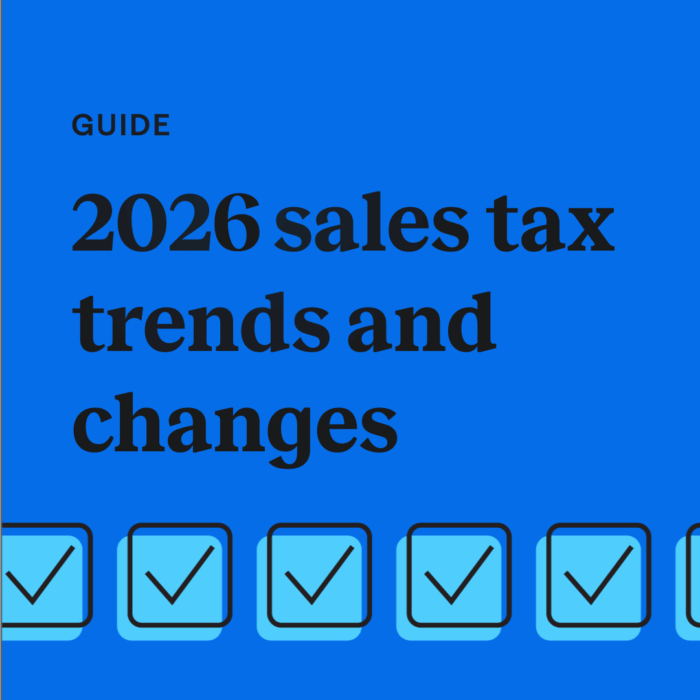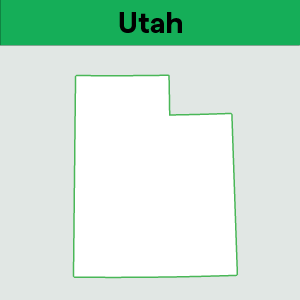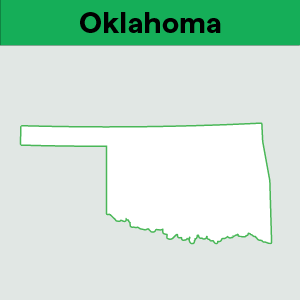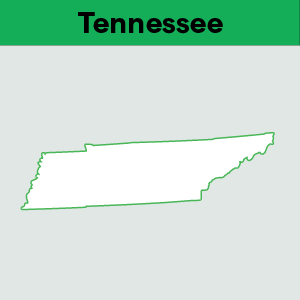Sales tax guide for artists
by December 30, 2024
When you own your own business you don’t want to spend a second longer than you have to dealing with complicated headaches like sales tax. This guide will provide artists with the info they need to get a handle on this administrative hassle.
While this article is US-centric, in some cases it also applies to international sellers selling into the US.
The basics of sales tax
Forty-six US states and Washington D.C. all have a sales tax. States and local areas use sales tax to pay for budget items like schools and roads. But states don’t collect sales tax from citizens directly. They rely on business owners like you to collect it from your buyers and then remit it from time to time (usually monthly, quarterly or annually.)
Each state’s laws regarding sales tax are a little different, but in general any “tangible personal property” is considered taxable. So, physical artwork like sculpture, paintings, jewelry, and other crafts are generally always taxable. (Unless you happen to be selling your signed and numbered original works in Rhode Island, which has declared itself a “tax free arts district.”) Digital artwork – like books, music and downloadable patterns are taxable in about half of the US states with a sales tax.
Sales tax rates also vary across states, counties, cities and other local areas. That’s why you might pay 6% in sales tax at a store in a suburb, but then drive 20 miles and pay 9% sales tax at a store within a city’s limits. Varying sales tax rates will determine how much sales tax you charge when selling your products.
Keep reading for a whole lot more info on when and how to charge sales tax on your artwork.
Subscribe to our free sales tax newsletter
Sales tax is complex, and always changing. But staying up to date on sales tax news is crucial for businesses. Sign up to stay on top of changes that can impact your sales tax compliance.
Sign upSales tax nexus: which customers should you charge sales tax?
In the US, you are only required to charge sales tax to buyers in states where you have sales tax nexus. Sales tax nexus is just a fancy way of saying a “significant presence” in a state.
If you are an artist who primarily works from your home or studio, then you might only have sales tax nexus in your home state. However, other business activities can create sales tax nexus, including:
- A location – a store, office, warehouse, factory or other location creates nexus
- An employee – employees, many contractors, sales people, installers and repairers create nexus
- A drop shipping relationship – Drop shipping can include using a 3rd party to print and send your designs, like t-shirts; depending on your negotiations with your drop shipper, you may have nexus if you drop ship
- An affiliate – some states consider 3rd party affiliates who send customers to your online store to create nexus
- Art shows or craft fairs – In some states, if you sell within their borders for just a handful of days (such as at a festival or craft fair) then you have nexus there
- Storing inventory in a warehouse – Storing inventory in a warehouse in a state, such as selling your Amazon Handmade products through Amazon FBA, creates nexus
If you have nexus in a state, collect sales tax from every buyer in that state – whether making an in-person sale, or shipping an online order to their address.
And if you are still unsure whether you have nexus, you can read what every state’s sales tax laws say about nexus here.
International sellers: if you have any of the above business activities in a US states with sales tax (like an employee in the States, or storing items for sale in Amazon fulfillment centers through FBA) then you may also have sales tax nexus.
When you discover that you have nexus in a state, your next step is to register for a sales tax permit in that state. Don’t skip this step! Most states consider it unlawful to collect sales tax without a permit. Find steps to register for a sales tax permit in every state here.
Handling sales tax with in-person sales
Whether you sell your artwork out of your studio or own a brick and mortar location, collecting sales tax in-person is one of the more painless ways to deal with sales tax.
The “point of sale” is important here. For in-person sales, the point of sale is where the two of you are standing while you make the sale. So you’d only be responsible to charge a single sales tax rate – the sales tax rate at the location where you are selling your items.
For example, you sell your items out of your studio in Sedona, Arizona, you’d charge all of your customers the 9.35% Sedona sales tax rate.
If you are selling from your booth at a craft fair in Duluth, Minnesota, you’d charge your buyer the 6.875% Duluth sales tax rate.
You can look up US sales tax rates here.
Sales tax at festivals and craft fairs
Now say you travel across state lines to sell at a festival or craft fair. Does that create nexus? As with almost every sales tax question, the answer is “it depends.”
Every state is different when it comes to sales tax on temporary sales such as at a craft fair or festival! Some states provide a wealth of information or special publications just for festival vendors. Other states treat every seller – from people who own in-state retail stores to people who are coming to the state to make sales for just a single weekend – just the same.
For example, when selling at a craft fair in Arkansas (as an out-of-state vendor) you are required to collect sales tax and turn it into the festival organizer daily. In Colorado, you are required to register for a “special event” sales tax license. But in Georgia, you are not required to register for a sales tax permit at all as long as you don’t make sales in the state for more than 5 days in the calendar year, or don’t collect more than $100,000 in sales over the course of the fair.
You can see what every state’s laws say about sales tax at festivals and craft fairs here.
Sales tax when selling online
Selling online is when sales tax starts to get tricky. If you only have nexus in your home state, you are only required to collect sales tax from buyers in your home state, even when selling to people all over the country online.
Though, unlike with in-person sales, the sales tax rate you charge your customers will likely vary when you are selling online. A handful of states are what is known as “origin-based” sales tax states, where you charge every customer in the state the sales tax rate at your business location. But most states are “destination-based” sales tax states, meaning you are required to charge your buyer sales tax at the sales tax rate at their ship to address.
For example, say you live in Stamford, NY but make a sale to a buyer in Buffalo, NY. Since New York, like most states, is a “destination-based” state, then you’d be required to charge your buyer the sales tax rate at their Buffalo ship to address.
Most online shopping carts and marketplaces have a sales tax engine that will allow you to collect the right amount of sales tax. Though some only let you set one sales tax rate per state, or ask you to manually enter the sales tax rate (or rates) you want to collect. You can read sales tax guide for most of the major shopping carts and marketplaces here.
You can read a whole lot more about origin and destination-based sales tax here.
Sales tax on shipping
When selling online, you also need to take sales tax on shipping into account. About half the states consider any shipping charges you charge your customer to be a taxable part of the sale. The other half say that shipping is non-taxable as long as you separately state the shipping charges on your invoice.
Here’s an example:
You sell a $100 necklace to and charge $5 in shipping to a customer in a state where shipping is taxable. In this case, you’d charge sales tax on the $105 total of the item cost + the shipping charge.
But you well the same $100 necklace and charge $5 in shipping to a customer in a state where shipping is NOT taxable. In this case, you would only be required to charge sales tax on the $100 price of the item.
Many only shopping carts and marketplaces allow you to specify whether you want to tax shipping. You can see which states consider shipping taxable here.
Sales tax and selling digital art
Do you sell digital art, like eBooks, original music or patterns? Then whether you are required to charge sales tax depends on the state’s rules.
One thing it’s important to remember about sales tax is that laws often have a hard time catching up with the way business is being done. Many states have never considered that 21st century businesses may be selling digital products, and their laws don’t address digital sales at all. Other states say that digital products are not taxable, because they are not “tangible.” Other states have decided that digital products are taxable.
Some states even consider some digital sales taxable, but others non-taxable. For example, in Idaho, a digital product is taxable if the buyer has permanent right to use it, but if the buyer only has a temporary right to the product (such as renting a digital movie for a limited amount of time), then the transaction is not taxable.
Read a whole lot more about charging sales tax on digital products here.
Sales tax when drop shipping
Drop shipping is one of the more complicated aspects of sales tax. In a drop shipping situation, you sell an item to your buyer, but have your vendor send the item to your customer.
Drop shipping example:
You sell t-shirts on your website, but use a 3rd party printing company to print your design on the shirts and ship them to your customer.
In this case there are three things going on:
- Your customer buys the item from you
- You buy the item from your vendor
- Your vendor ships the item to your customer
In this case, if your vendor has nexus in your state, they’ll be required to charge your sales tax on that purchase unless you present them with a resale certificate stating that the item you bought from them is for resale. And if your customer is in a state where you have nexus, then you’ll be required to charge sales tax to your customer.
Though drop shipping can get complicated, this means that depending on where the three of you – you, your vendor and your customer – are located, you may be required to charge your customer sales tax, and your vendor may charge you sales tax.
You can read a lot more about dropshipping and sales tax here. The blog post walks you through a number of scenarios to help you determine who charges sales tax.
Filing your sales tax returns
So you’ve done everything right and have been charging sales tax to your buyers. Soon enough, your sales tax filing due date will roll around.
Sales tax filing due dates vary by state, but are generally either monthly, quarterly or annually. As a general rule, the more sales tax you collect from buyers in a state, the more often that state is going to want you to file a sales tax return.
If you only make in-person sales from one or two locations, filing a sales tax return is fairly simple. You just tally up how much sales tax you collected from buyers in a state, find your jurisdiction or jurisdictions on the state sales tax filing form, and enter how much you collected. You will likely have to break down the amounts you collected in state, county and city taxes, but if you only have one or two locations this is fairly doable.
On the other hand, if you sell online and have collected sales tax from buyers in many jurisdictions, filing sales tax is much more difficult. Keep in mind that states and local areas all use the sales tax you collected to pay for things like schools and fire departments. Because of this, states require that you break down how much sales tax you collected by state, county, city and other district so they know how to allocate the sales tax funds you are going to send them.
If you made online sales and collected multiple sales tax rates, filing your sales tax return can quickly turn into a time-consuming headache. That’s why we created TaxJar.
TaxJar will connect with your online shopping carts and marketplaces, and break down all the sales tax you collected by county, city and more, and give you a report detailing just exactly what the state wants to see. And if you’d rather do anything else than file a sales tax return, we’ll even AutoFile your sales tax returns for you so you never have to see a sales tax filing every again.
There are a couple of important things to remember when filing your sales tax returns:
- Always file “zero returns” – Always file a sales tax return by the due date, even if you didn’t make any sales. States consider sales tax returns a check in, and if you fail to file – even if you don’t have any sales tax to remit – they will often charge you a fine. And nobody wants to pay a fine when you didn’t even owe any money in the first place!
- Take your sales tax discounts – About half the states with a sales tax will let business owners who file sales tax on time keep a very small portion of the sales tax you collected. While this amount is generally only about 1% of the sales tax you collected, it’s free money! (If TaxJar AutoFiles your sales tax return for you, we’re careful to make sure you keep your discount.)
How common artists’ marketplaces handle sales tax
Online shopping carts and marketplaces vary in how well the handle sales tax. Some marketplaces, like Amazon Handmade, offer very deep tools to help you collect sales tax correctly every time. Others, like Smashwords, a digital book marketplace for writers, don’t collect sales tax from your buyer at all, and leave you to handle it and pay out of pocket.
Etsy
The most popular handmade marketplace on the internet needs no introduction. But when it comes to handling sales tax, Etsy gets a little more complicated.
Etsy does not calculate how much sales tax you should collect. Instead, they allow you to enter how much sales tax you want to collect from buyers by state and zip code. This works great if you live in an origin-based state. You can simply tell Etsy to collect the same amount of sales tax from all buyers.
But if you live in a destination-based state where you are supposed to collect sales tax based on your buyer’s ship to address, you’ll be required to enter all the sales tax rates from your state. Ouch! They also only allow you to enter sales tax by 5-digit zip code, which, while mostly accurate, doesn’t always get it right.
You have a couple of options when dealing with sales tax on Etsy:
- Enter every tax rate in your state by zip code – You can often, but not always, find this information on your state’s department of revenue website. Some small states only have a handful of tax rates, so your task will be fairly simple. Other states have hundreds of tax rates so this can turn into a time-consuming pain. You’ll also need to be sure that you update your sales tax rate every time your state or local area makes a change to the sales tax rate. Ouch.
- Collect an average sales tax rate from buyers in the state – Another option is to collect and average sales tax rate for a state. In this case, you’ll charge the right amount of sales tax in many cases, but may also slightly under or over charge in some cases. While this
Neither of these scenarios will help you collect sales tax with Etsy perfectly, but you are working within the limitations of Etsy’s sales tax engine. When it comes time to file your sales tax returns, TaxJar can help you. Our “Actual vs. Expected Sales Tax Collected” report will show you host much sales tax you collected vs. what TaxJar’s robust sales tax engine calculates that you should have collected. This will ensure that you accurately report and pay the right amount of sales tax you should have collected, even if you were limited in how you could actually collect sales tax from your customers.
With Etsy, you can also mark certain items as non-taxable. For example, if you sell vintage clothing and have sales tax nexus in Pennsylvania, you wouldn’t want to charge sales tax, since clothing is not taxable in PA.
You can read more about sales tax on Etsy in the Etsy Handbook.
Amazon Handmade
Amazon Handmade is Amazon’s answer to Etsy, with the added advantage that they allow you to sell your handmade items on one of the largest online marketplaces in the world.
Amazon will charge sales tax to your buyers on your behalf. But this means you have to tell them in which states you want to collect, and give them some more information so they know how to handle scenarios like sales tax on shipping or sales tax on giftwrapping. For use of this service, Amazon charges 2.9% of the sales tax they collect.
After Amazon collects the sales tax, they remit it to you in your disbursements. From there, it’s up to you to report how much sales tax you collected in each state, county, city and special taxing jurisdiction and to file your sales tax return with the state.
Amazon also allows you to tag products with “product tax codes” so that they if one of your products is something like clothing, which is taxed differently in different states. Once you code your product with the right product tax code, Amazon’s sales tax engine will ensure that you always collect (or don’t collect) the right amount of sales tax on it.
Important note on Amazon FBA:
Some Amazon Handmade sellers elect to use Amazon FBA. Fulfillment by Amazon is great in that it allows you to send your merchandise into Amazon and they take care of all the legwork of storing and shipping it to your customer. However, storing inventory in a warehouse in a state creates sales tax nexus. If you’re using Amazon FBA, you can see where your inventory is stored (and thus where you have sales tax nexus) in your Inventory Event Detail report in Amazon Seller Central or, if you’re a TaxJar user, in your TaxJar account.
Merch by Amazon
With Merch by Amazon, you submit your designs and, when a sale is made, Amazon prints those designs on a t-shirt or other item and ships that item to the customer. The good news is that Amazon is the “seller of record” in this case. They send you a royalty when a shirt is sold, but you are not required to charge or file sales tax.
Zazzle
The Zazzle Makers program is similar to Amazon Handmade in that they allow you to tell them in which states you need to collect sales tax, and they will collect on your behalf, then send the money to you in your remittances. You are then required to file a sales tax return and remit the sales tax Zazzle collected on your behalf back to the state.
Printful
Printful is a print on demand (POD) service that prints your custom designs on t-shirts, hats, phone cases and other swag on your behalf, and then ships them to your customer. They have locations in California and North Carolina. This means that if you have them ship an item to a customer in CA or NC, they will charge you sales tax unless you have submitted a resale certificate in your Printful account.
Most states, including North Carolina, will accept your home state sales tax license as your resale certificate. However, California only accepts a California sales tax permit as a resale certificate. This means that if you don’t want Printful to charge you sales tax on your orders that are shipped to your buyers, you’d need to register for a California sales tax permit and begin collecting and remitting sales tax in California yourself.
While this is your business decision to make, it pays to look at your numbers. California sales tax is generally 7.5-9%. If you don’t make many sales to California, you may choose to absorb this cost. But if you make many sales to California, you may decide that losing 7-9% on each sale isn’t worth it and choose to register for a California sales tax return and collect sales tax from your California customers.
Creative Market
At Creative Market, much like Merch by Amazon, sellers receive royalties when their designs or other work sells. The good news here is that you are not on the hook to deal with sales tax in this case.
Red Bubble
At Red Bubble, much like Merch by Amazon and Creative Market, sellers receive royalties when their designs or other work sells. Each party is responsible for their own taxes associated with each transaction and will account for any taxes imposed by governments or governing authorities.
Psst! Do you want more info about sales tax on another creative platform? Let us know in the comments and we’ll do the research!
Frequently asked questions
Business owners frequently ask us these questions:
I online sell online and work from home. Do I still need to collect sales tax?
Yes. Most state laws say that anyone sell taxable items at retail should collect sales tax, no matter if you work from home or only sell on the internet.
The two exceptions are Colorado, that allows home-based businesses making occasional sales of less than $1,000 to refrain from collecting sales tax, and Tennessee, which requires that sellers make more than either $400/month or $4800/year in gross sales before being required to register for a sales tax permit and collect sales tax.
When should I start collecting sales tax?
It’s advisable to always collect sales tax from buyers in your home state. If nothing else, this is because it’s fairly easy for your home state to realize you’re not collecting sales tax and assess fines and penalties.
If you are just starting out but find that you have nexus in other states, you may want to assess your “materiality” in those states.
Example:
You use Amazon FBA and have nexus in Kansas due to Amazon storing your Amazon Handmade products there. But you only make one sale per year in Kansas, and should have collected about $10 in sales tax. The letter of the law states that you should register for a sales tax permit and collect sales tax from your Kansas buyers. But you notice that it would cost you more in time to comply with Kansas sales tax laws than it would to pay the fine should Kansas notice that missing $10 in sales tax revenue. This business decision is entirely up to you. We have a lot more info on when to begin collecting sales tax here.
I haven’t been collecting sales tax, but I want to get compliant. What do I do?
We talk to many business owners who started up organically and missed the fact that they need to collect sales tax.
Step 1: Find out how much sales tax you should have collected
In this case, the first step is to get info. How much sales tax should you have collected had you been collecting?
You can quickly see this number by connecting your online shopping carts and marketplaces with your TaxJar account.
This is the TaxJar account of a small business owner who hasn’t been collecting sales tax in Connecticut. This shows she should have collected $29 in sales tax over the past month. (To see more info, she can change “Monthly” to “Yearly” here, and even import her sales data from past years.)
Step 2: Make a business decision
You have a couple of options here, and this is where you decide your appetite for risk.
- Come clean with the state and tell them how long you haven’t been collecting sales tax – They will charge your fines and interest on top of the amount of past due sales tax you owe.
- Register for a sales tax permit starting today – This is a gray area, so you should tread carefully here. But if you do decide to start collecting sales tax starting today, you are telling the state that you only started selling online today. You can mitigate some of the risk by including all the sales tax you “should” have collected to your first payment to the state. Just keep in mind that this is risky should the state realize you should have been collecting sales tax all along.
- Obtain a voluntary disclosure – If you owe a large amount of past due sales tax, you have a third option. You can work with a vetted sales tax expert to come to a “voluntary disclosure agreement” (VDA) with your state. In this process, your sales tax expert negotiates with the state so that you can pay a lesser amount of the past due sales tax, penalties and interest you owe. In exchange, you agree to continue collecting and remitting sales tax going forward.
The best and most cost-effective policy is to begin collecting sales tax from your buyers right from the start. But if you weren’t compliant (and it’s very easy to overlook the fact that you should be!) then the three above options should give you a starting point.
My online shopping cart/marketplace doesn’t let me collect sales tax. What do I do?
A few online shopping carts and marketplaces make no provision for sales tax. This can be incredibly frustrating for an online seller who is just trying to do the right thing.
However, if you find yourself selling online with no way to automatically collect sales tax, TaxJar has your back.
Download a .csv report of your transactions from this marketplace, then upload it to TaxJar via our .csv upload feature. We’ll calculate how much sales tax you should have collected on those sales. From there, you’ll know how much sales tax you should remit to a state.
Another option is, of course, to ask the customer separately to pay the sales tax. But we don’t recommend this, as you’ll likely only end up with confused, angry customers wondering why you’re coming back and asking for more money.








